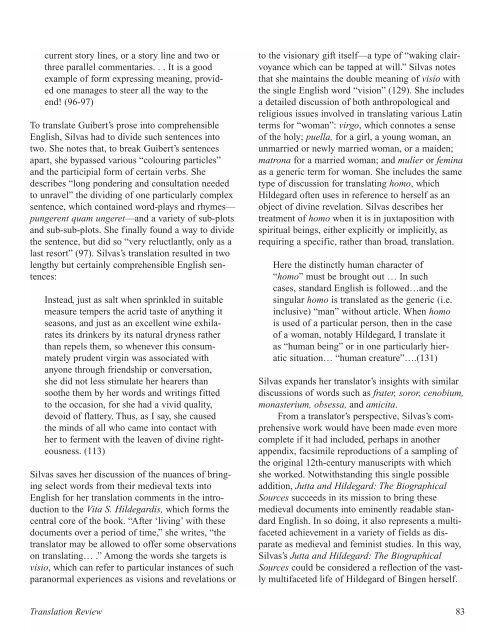Translation Review - The University of Texas at Dallas
Translation Review - The University of Texas at Dallas
Translation Review - The University of Texas at Dallas
Create successful ePaper yourself
Turn your PDF publications into a flip-book with our unique Google optimized e-Paper software.
current story lines, or a story line and two or<br />
three parallel commentaries. . . It is a good<br />
example <strong>of</strong> form expressing meaning, provided<br />
one manages to steer all the way to the<br />
end! (96-97)<br />
To transl<strong>at</strong>e Guibert’s prose into comprehensible<br />
English, Silvas had to divide such sentences into<br />
two. She notes th<strong>at</strong>, to break Guibert’s sentences<br />
apart, she bypassed various “colouring particles”<br />
and the participial form <strong>of</strong> certain verbs. She<br />
describes “long pondering and consult<strong>at</strong>ion needed<br />
to unravel” the dividing <strong>of</strong> one particularly complex<br />
sentence, which contained word-plays and rhymes—<br />
pungerent quam ungeret—and a variety <strong>of</strong> sub-plots<br />
and sub-sub-plots. She finally found a way to divide<br />
the sentence, but did so “very reluctlantly, only as a<br />
last resort” (97). Silvas’s transl<strong>at</strong>ion resulted in two<br />
lengthy but certainly comprehensible English sentences:<br />
Instead, just as salt when sprinkled in suitable<br />
measure tempers the acrid taste <strong>of</strong> anything it<br />
seasons, and just as an excellent wine exhilar<strong>at</strong>es<br />
its drinkers by its n<strong>at</strong>ural dryness r<strong>at</strong>her<br />
than repels them, so whenever this consumm<strong>at</strong>ely<br />
prudent virgin was associ<strong>at</strong>ed with<br />
anyone through friendship or convers<strong>at</strong>ion,<br />
she did not less stimul<strong>at</strong>e her hearers than<br />
soothe them by her words and writings fitted<br />
to the occasion, for she had a vivid quality,<br />
devoid <strong>of</strong> fl<strong>at</strong>tery. Thus, as I say, she caused<br />
the minds <strong>of</strong> all who came into contact with<br />
her to ferment with the leaven <strong>of</strong> divine righteousness.<br />
(113)<br />
Silvas saves her discussion <strong>of</strong> the nuances <strong>of</strong> bringing<br />
select words from their medieval texts into<br />
English for her transl<strong>at</strong>ion comments in the introduction<br />
to the Vita S. Hildegardis, which forms the<br />
central core <strong>of</strong> the book. “After ‘living’ with these<br />
documents over a period <strong>of</strong> time,” she writes, “the<br />
transl<strong>at</strong>or may be allowed to <strong>of</strong>fer some observ<strong>at</strong>ions<br />
on transl<strong>at</strong>ing… .” Among the words she targets is<br />
visio, which can refer to particular instances <strong>of</strong> such<br />
paranormal experiences as visions and revel<strong>at</strong>ions or<br />
to the visionary gift itself—a type <strong>of</strong> “waking clairvoyance<br />
which can be tapped <strong>at</strong> will.” Silvas notes<br />
th<strong>at</strong> she maintains the double meaning <strong>of</strong> visio with<br />
the single English word “vision” (129). She includes<br />
a detailed discussion <strong>of</strong> both anthropological and<br />
religious issues involved in transl<strong>at</strong>ing various L<strong>at</strong>in<br />
terms for “woman”: virgo, which connotes a sense<br />
<strong>of</strong> the holy; puella, for a girl, a young woman, an<br />
unmarried or newly married woman, or a maiden;<br />
m<strong>at</strong>rona for a married woman; and mulier or femina<br />
as a generic term for woman. She includes the same<br />
type <strong>of</strong> discussion for transl<strong>at</strong>ing homo, which<br />
Hildegard <strong>of</strong>ten uses in reference to herself as an<br />
object <strong>of</strong> divine revel<strong>at</strong>ion. Silvas describes her<br />
tre<strong>at</strong>ment <strong>of</strong> homo when it is in juxtaposition with<br />
spiritual beings, either explicitly or implicitly, as<br />
requiring a specific, r<strong>at</strong>her than broad, transl<strong>at</strong>ion.<br />
Here the distinctly human character <strong>of</strong><br />
“homo” must be brought out … In such<br />
cases, standard English is followed…and the<br />
singular homo is transl<strong>at</strong>ed as the generic (i.e.<br />
inclusive) “man” without article. When homo<br />
is used <strong>of</strong> a particular person, then in the case<br />
<strong>of</strong> a woman, notably Hildegard, I transl<strong>at</strong>e it<br />
as “human being” or in one particularly hier<strong>at</strong>ic<br />
situ<strong>at</strong>ion… “human cre<strong>at</strong>ure”….(131)<br />
Silvas expands her transl<strong>at</strong>or’s insights with similar<br />
discussions <strong>of</strong> words such as fr<strong>at</strong>er, soror, cenobium,<br />
monasterium, obsessa, and amicita.<br />
From a transl<strong>at</strong>or’s perspective, Silvas’s comprehensive<br />
work would have been made even more<br />
complete if it had included, perhaps in another<br />
appendix, facsimile reproductions <strong>of</strong> a sampling <strong>of</strong><br />
the original 12th-century manuscripts with which<br />
she worked. Notwithstanding this single possible<br />
addition, Jutta and Hildegard: <strong>The</strong> Biographical<br />
Sources succeeds in its mission to bring these<br />
medieval documents into eminently readable standard<br />
English. In so doing, it also represents a multifaceted<br />
achievement in a variety <strong>of</strong> fields as dispar<strong>at</strong>e<br />
as medieval and feminist studies. In this way,<br />
Silvas’s Jutta and Hildegard: <strong>The</strong> Biographical<br />
Sources could be considered a reflection <strong>of</strong> the vastly<br />
multifaceted life <strong>of</strong> Hildegard <strong>of</strong> Bingen herself.<br />
<strong>Transl<strong>at</strong>ion</strong> <strong>Review</strong> 83

















